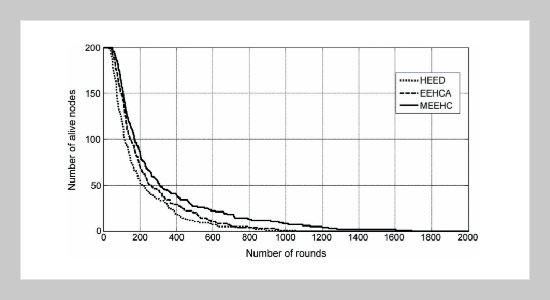REFERENCES
- [1] Mhatre, Vivek P. and Catherine Rosenberg, “Homogeneous vs. Heterogeneous Clustered Sensor Networks: A Comparative Study,” in Proc. IEEE Int. Conf. on Communications (ICC 2004), Vol. 27, pp. 3646�3651 (2004).
- [2] Stefano, C., Chilamkurti, N. and Zeadally, S. “A Novel Centralized Clustering Algorithm for Energy Efficient Wireless Sensor Networks,” International Journal of Autonomous and Adaptive Communications Systems, Vol. 1, pp. 242�261 (2008).
- [3] Stanislava Soro and Wendi B. Heinzelman, “Prolonging the Lifetime of Wireless Sensor Networks via Unequal Clustering,” in Proc. 5th IEEE Int. Workshop on Algorithms for Wireless, Mobile, Ad Hoc and Sensor Networks 2005 (WMAN’05), Denver, Colorado, April 4th�8th (2005).
- [4] Yuan, L. and Gui, C., “Applications and Design of Heterogeneous and/or Broadband Sensor Networks,” in Proc. IEEE First Workshop on Broadband Ad - vanced Sensor Networks (Basenets), October (2004).
- [5] Heinzelman, W. R., Chandrakasan, A. and Balakrishnan, H., “Application Specific Protocol Architecture for Wireless Sensor Network,” Ph.D Thesis, Massachusetts Institute of Technology (2002).
- [6] Wei, D., Kaplan, S. and Chan, H. A., “Energy Efficient Clustering Algorithms for Wireless Sensor Networks,” in Proc. IEEE Intl. Conf. of Communication (ICC 2008), pp. 236�240 (2008).
- [7] Vlajic, N. and Xia, D., “Wireless Sensor Networks: To Cluster or Not to Cluster?” in Proc. Intl. Symposium on World of Wireless, Mobile and Multimedia Network (WoWMoM’06), pp. 258�268 (2006).
- [8] Yu J. and Chong, P., “A Survey of Clustering Schemes for Mobile Ad Hoc Networks,” in Proc. IEEE Communication Surveys, Vol.7, pp. 32�48 (2005).
- [9] Jang, W. S., Heley, W. M. and Skibniewsk, M. J., “Wireless Sensor Networks as a Part of Web Based Building Environment Monitoring System,” Journal of Automation in Construction, Vol. 17, pp. 729�736 (2008).
- [10] Ye, M., Li, C., Chen, G. and Wu, J., “EECS: An Energy Efficient Clustering Scheme in Wireless Sensor Networks,” in Proc. IEEE Intl. Performance Computing and Communication Conf. (IPCCC 2005), Phonenix, Arizona, pp. 535�540 (2005).
- [11] Chen, H. and Megerian, S., “Cluster Sizing and Head Selection for Efficient Data Aggregation and Routing in Sensor Networks,” in Proc. IEEE Wireless Communication and Networking Conf. (WCNC-2006), Las Vegas, USA, pp. 2318�2323 (2006).
- [12] Israr, N. and Awan, I. U., “Multihop Routing Algorithm for Inter CH Communication,” in Proc. 22nd UK Performance Engineering Workshop Bournemouth UK, pp. 24�31 (2006).
- [13] Smaragdakis, G., Matta, I. and Bestavros, A., “SEP: A Stable Election Protocol for Clustered Heterogeneous Wireless Sensor Networks,” in Proceedings of Second International Workshop on Sensor and Actor Network Protocols and Applications (SANPA 2004), Boston, MA, August (2004).
- [14] Xin, G., Yang, W. H. and Gang, D. De., “EEHCA: An Energy-Efficient Clustering Algorithm for Wireless Sensor Networks,” Information Technology Journal, Vol. 7, pp. 245�252 (2008).
- [15] Younis, O. and Fahmy, S., “HEED: A Hybrid Energy Efficient Distributed Clustering Approach for Ad Hoc Sensor Networks,” IEEE Transactions on Mobile Computing, Vol. 3, pp. 660�669 (2004).
- [16] Xianging, F. and Yulin, S., “Improvement on LEACH Protocol of Wireless Sensor Networks,” in Proceeding of International Conference on Sensor Technologies and Applications, pp. 260�264 (2007).
- [17] Soro, S. and Heinzelman, W. B., “Cluster Head Election Techniques for Coverage Presentation in Wireless Sensor Networks,” Ad Hoc Networks, Vol. 7, pp. 955� 972 (2009).
- [18] Chen, G., Li, C., Ye, M. and Wu, J., “An Unequal Cluster-Based Routing Protocol in Wireless Sensor Networks,” Wireless Networks, Springer, Vol. 15, pp. 193�207 (2009).
- [19] Kumar, D., Aseri, T. C. and Patel, R. B., “EECDA: Energy-Efficient Clustering and Data Aggregation Protocol for Heterogeneous Wireless Sensor Networks,” International Journal of Computers, Communication and Control, Romania, Vol. 6, pp. 113�124 (2011).
















